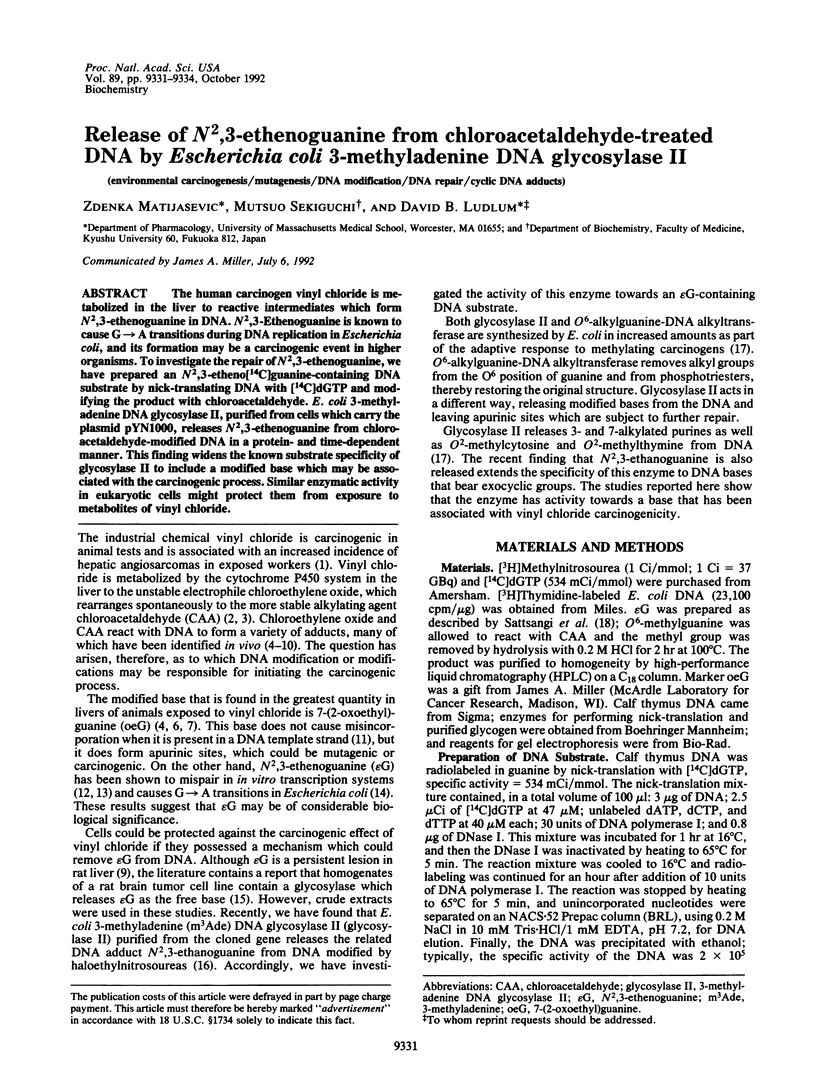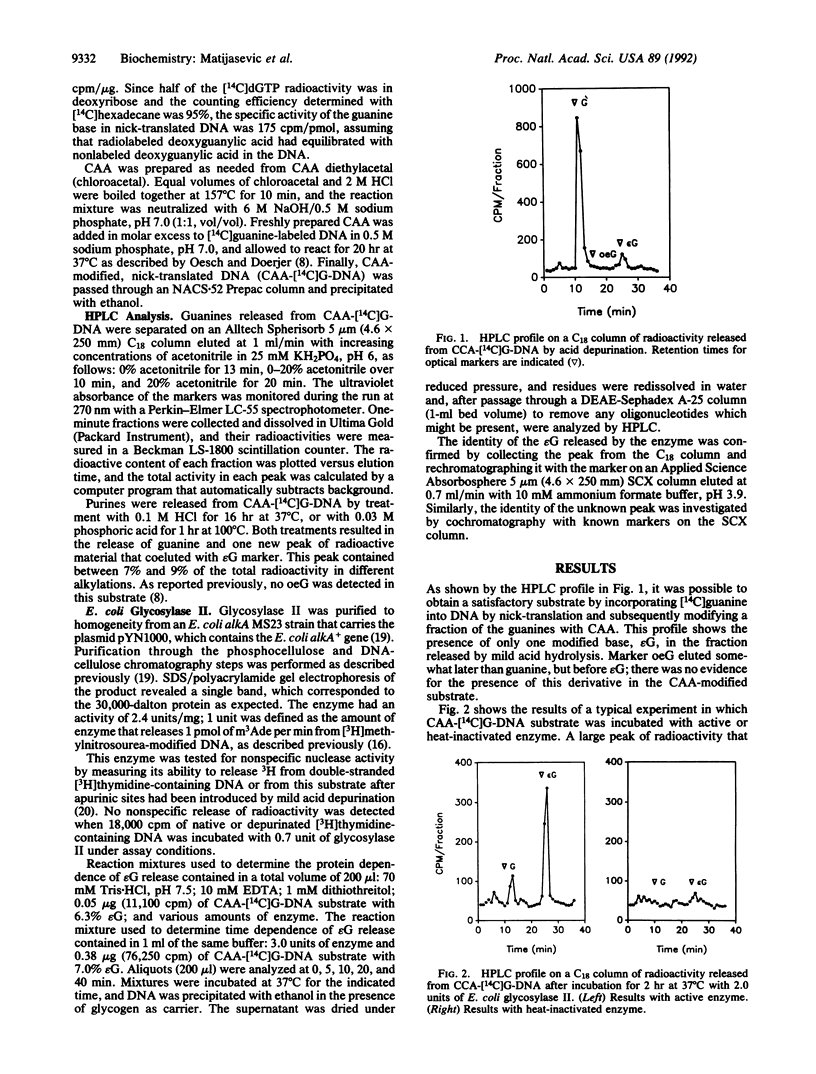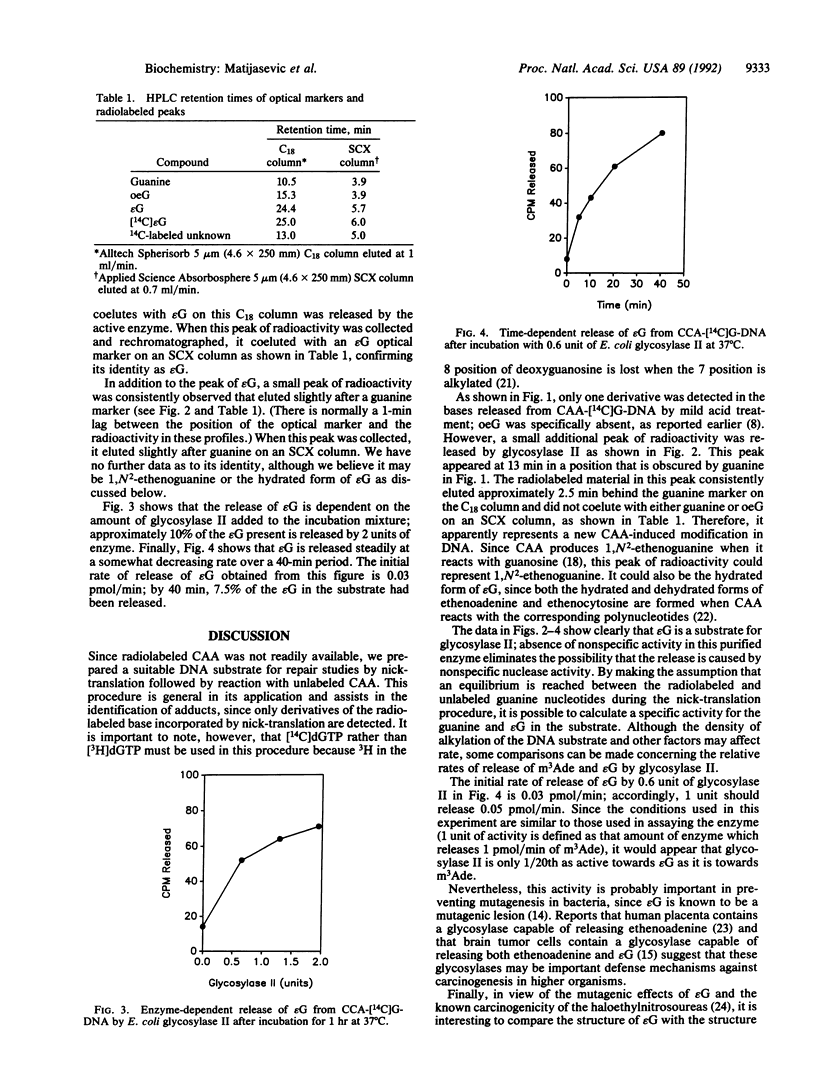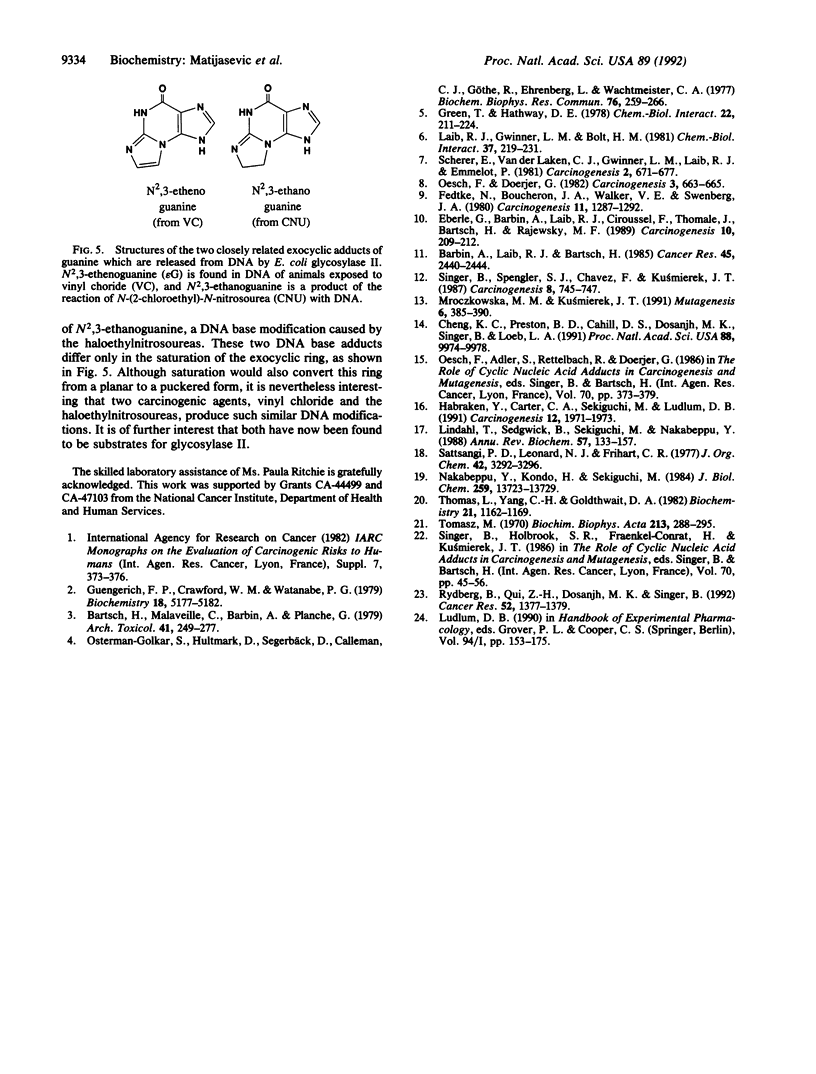Abstract
The human carcinogen vinyl chloride is metabolized in the liver to reactive intermediates which form N2,3-ethenoguanine in DNA. N2,3-Ethenoguanine is known to cause G----A transitions during DNA replication in Escherichia coli, and its formation may be a carcinogenic event in higher organisms. To investigate the repair of N2,3-ethenoguanine, we have prepared an N2,3-etheno[14C]guanine-containing DNA substrate by nick-translating DNA with [14C]dGTP and modifying the product with chloroacetaldehyde. E. coli 3-methyladenine DNA glycosylase II, purified from cells which carry the plasmid pYN1000, releases N2,3-ethenoguanine from chloroacetaldehyde-modified DNA in a protein- and time-dependent manner. This finding widens the known substrate specificity of glycosylase II to include a modified base which may be associated with the carcinogenic process. Similar enzymatic activity in eukaryotic cell might protect them from exposure to metabolites of vinyl chloride.
Full text
PDF



Selected References
These references are in PubMed. This may not be the complete list of references from this article.
- Barbin A., Laib R. J., Bartsch H. Lack of miscoding properties of 7-(2-oxoethyl)guanine, the major vinyl chloride-DNA adduct. Cancer Res. 1985 Jun;45(6):2440–2444. [PubMed] [Google Scholar]
- Bartsch H., Malaveille C., Barbin A., Planche G. Mutagenic and alkylating metabolites of halo-ethylenes, chlorobutadienes and dichlorobutenes produced by rodent or human liver tissues. Evidence for oxirane formation by P450-linked microsomal mono-oxygenases. Arch Toxicol. 1979 Feb 23;41(4):249–277. doi: 10.1007/BF00296896. [DOI] [PubMed] [Google Scholar]
- Cheng K. C., Preston B. D., Cahill D. S., Dosanjh M. K., Singer B., Loeb L. A. The vinyl chloride DNA derivative N2,3-ethenoguanine produces G----A transitions in Escherichia coli. Proc Natl Acad Sci U S A. 1991 Nov 15;88(22):9974–9978. doi: 10.1073/pnas.88.22.9974. [DOI] [PMC free article] [PubMed] [Google Scholar]
- Eberle G., Barbin A., Laib R. J., Ciroussel F., Thomale J., Bartsch H., Rajewsky M. F. 1,N6-etheno-2'-deoxyadenosine and 3,N4-etheno-2'-deoxycytidine detected by monoclonal antibodies in lung and liver DNA of rats exposed to vinyl chloride. Carcinogenesis. 1989 Jan;10(1):209–212. doi: 10.1093/carcin/10.1.209. [DOI] [PubMed] [Google Scholar]
- Fedtke N., Boucheron J. A., Walker V. E., Swenberg J. A. Vinyl chloride-induced DNA adducts. II: Formation and persistence of 7-(2'-oxoethyl)guanine and N2,3-ethenoguanine in rat tissue DNA. Carcinogenesis. 1990 Aug;11(8):1287–1292. doi: 10.1093/carcin/11.8.1287. [DOI] [PubMed] [Google Scholar]
- Green T., Hathway D. E. Interactions of vinyl chloride with rat-liver DNA in vivo. Chem Biol Interact. 1978 Sep;22(2-3):211–224. doi: 10.1016/0009-2797(78)90126-6. [DOI] [PubMed] [Google Scholar]
- Guengerich F. P., Crawford W. M., Jr, Watanabe P. G. Activation of vinyl chloride to covalently bound metabolites: roles of 2-chloroethylene oxide and 2-chloroacetaldehyde. Biochemistry. 1979 Nov 13;18(23):5177–5182. doi: 10.1021/bi00590a023. [DOI] [PubMed] [Google Scholar]
- Habraken Y., Carter C. A., Sekiguchi M., Ludlum D. B. Release of N2,3-ethanoguanine from haloethylnitrosourea-treated DNA by Escherichia coli 3-methyladenine DNA glycosylase II. Carcinogenesis. 1991 Oct;12(10):1971–1973. doi: 10.1093/carcin/12.10.1971. [DOI] [PubMed] [Google Scholar]
- Laib R. J., Gwinner L. M., Bolt H. M. DNA alkylation by vinyl chloride metabolites: etheno derivatives or 7-alkylation of guanine? Chem Biol Interact. 1981 Oct;37(1-2):219–231. doi: 10.1016/0009-2797(81)90179-4. [DOI] [PubMed] [Google Scholar]
- Lindahl T., Sedgwick B., Sekiguchi M., Nakabeppu Y. Regulation and expression of the adaptive response to alkylating agents. Annu Rev Biochem. 1988;57:133–157. doi: 10.1146/annurev.bi.57.070188.001025. [DOI] [PubMed] [Google Scholar]
- Mroczkowska M. M., Kuśmierek J. T. Miscoding potential of N2,3-ethenoguanine studied in an Escherichia coli DNA-dependent RNA polymerase in vitro system and possible role of this adduct in vinyl chloride-induced mutagenesis. Mutagenesis. 1991 Sep;6(5):385–390. doi: 10.1093/mutage/6.5.385. [DOI] [PubMed] [Google Scholar]
- Nakabeppu Y., Kondo H., Sekiguchi M. Cloning and characterization of the alkA gene of Escherichia coli that encodes 3-methyladenine DNA glycosylase II. J Biol Chem. 1984 Nov 25;259(22):13723–13729. [PubMed] [Google Scholar]
- Oesch F., Doerjer G. Detection of N2,3-ethanoguanine in DNA after treatment with chloroacetaldehyde in vitro. Carcinogenesis. 1982;3(6):663–665. doi: 10.1093/carcin/3.6.663. [DOI] [PubMed] [Google Scholar]
- Osterman-Golkar S., Hultmark D., Segerbäck D., Calleman C. J., Göthe R., Ehrenberg L., Wachtmeister C. A. Alkylation of DNA and proteins in mice exposed to vinyl chloride. Biochem Biophys Res Commun. 1976 May 23;76(2):259–266. doi: 10.1016/0006-291x(77)90720-3. [DOI] [PubMed] [Google Scholar]
- Rydberg B., Qiu Z. H., Dosanjh M. K., Singer B. Partial purification of a human DNA glycosylase acting on the cyclic carcinogen adduct 1,N6-ethenodeoxyadenosine. Cancer Res. 1992 Mar 1;52(5):1377–1379. [PubMed] [Google Scholar]
- Sattsangi P. D., Leonard N. J., Frihart C. R. 1,N2-ethenoguanine and N2,3-ethenoguanine. Synthesis and comparison of the electronic spectral properties of these linear and angular triheterocycles related to the Y bases. J Org Chem. 1977 Sep 30;42(20):3292–3296. doi: 10.1021/jo00440a020. [DOI] [PubMed] [Google Scholar]
- Scherer E., Van der Laken C. J., Gwinner L. M., Laib R. J., Emmelot P. Modification of deoxyguanosine by chloroethylene oxide. Carcinogenesis. 1981;2(7):671–677. doi: 10.1093/carcin/2.7.671. [DOI] [PubMed] [Google Scholar]
- Singer B., Spengler S. J., Chavez F., Kuśmierek J. T. The vinyl chloride-derived nucleoside, N2,3-ethenoguanosine, is a highly efficient mutagen in transcription. Carcinogenesis. 1987 May;8(5):745–747. doi: 10.1093/carcin/8.5.745. [DOI] [PubMed] [Google Scholar]
- Thomas L., Yang C. H., Goldthwait D. A. Two DNA glycosylases in Escherichia coli which release primarily 3-methyladenine. Biochemistry. 1982 Mar 16;21(6):1162–1169. doi: 10.1021/bi00535a009. [DOI] [PubMed] [Google Scholar]
- Tomasz M. Novel assay of 7-alkylation of guanine residues in DNA. Application to nitrogen mustard, triethylenemelamine and mitomycin C. Biochim Biophys Acta. 1970 Aug 8;213(2):288–295. doi: 10.1016/0005-2787(70)90037-7. [DOI] [PubMed] [Google Scholar]


